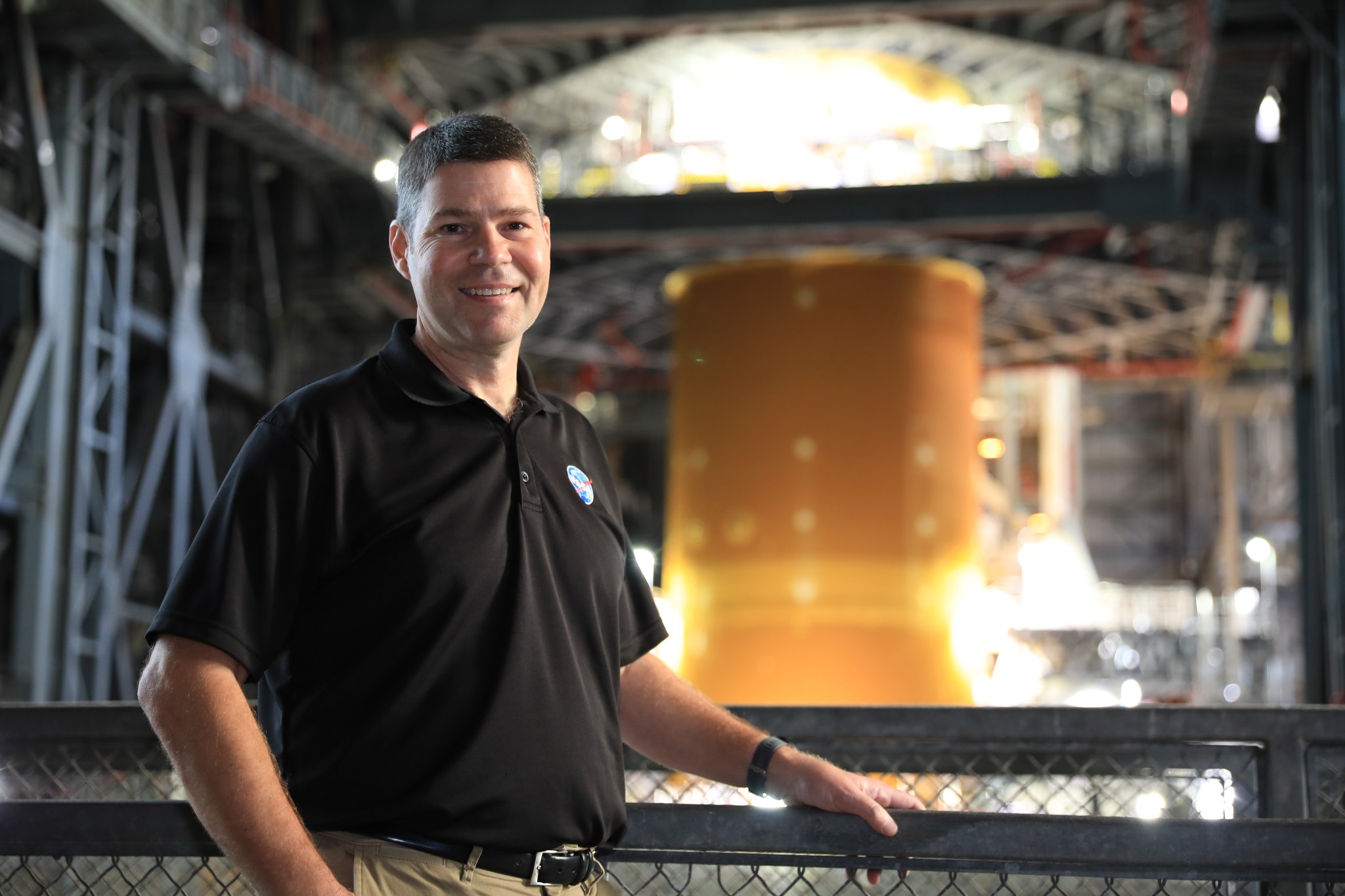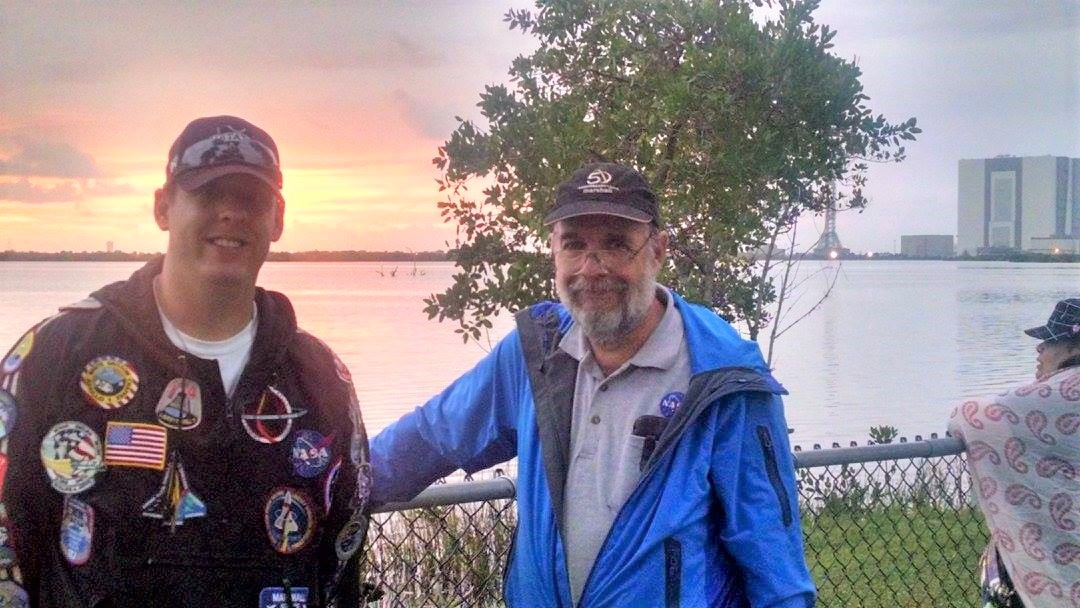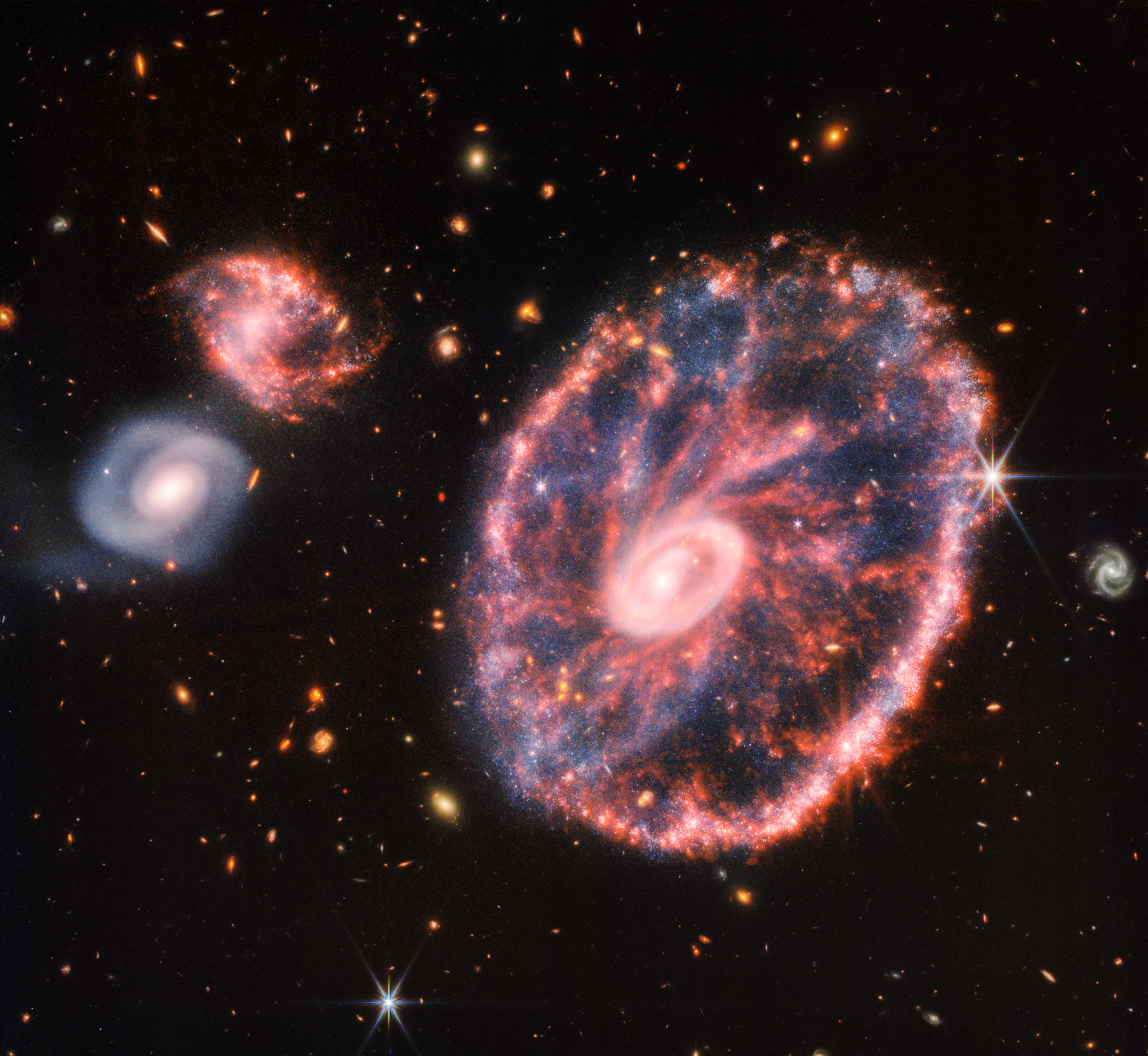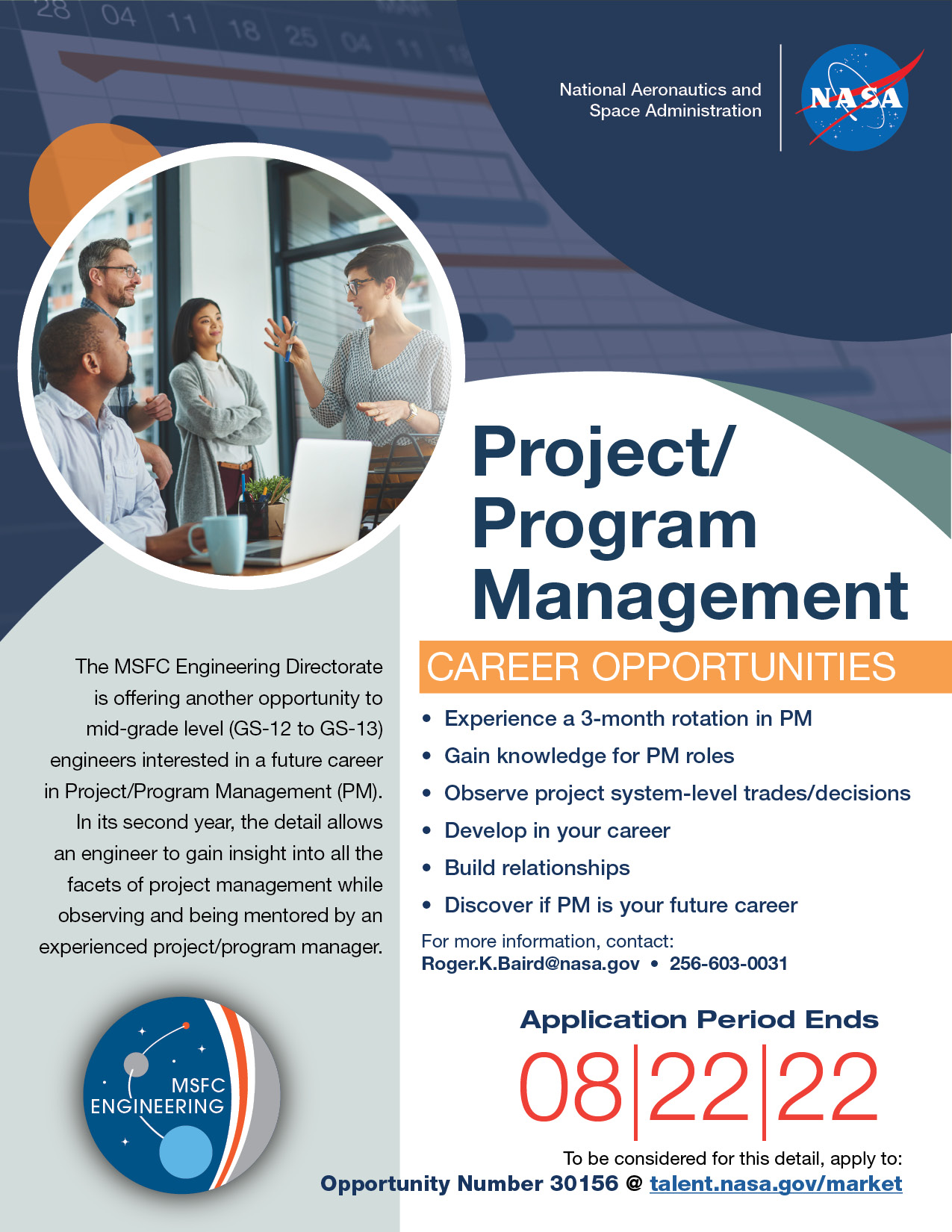In This Week’s Star
- Early Days of Space Exploration Inspire Illinois Native to NASA Career
- NASA’s Dr. John Blevins was with SLS Before There was an SLS
- Lead-up to Launch: Will Bryan
- Singer Delivers Keynote Speech at Leadership Alabama Conference
- Webb Captures Stellar Gymnastics in the Cartwheel Galaxy
- Engineering Directorate Returns Project/Program Management Detail
Early Days of Space Exploration Inspire Illinois Native to NASA Career
By Gina Hannah
Andy Schorr’s childhood encounters with the idea of space travel were awe-inspiring, if not intimidating: A Sounds of the Space Age record tucked inside the pages of his father’s December 1969 National Geographic magazine. Spying the Moon rock on display at the U.S. Space & Rocket Center in Huntsville during a family vacation in the 1970s.
“Even though the rock was encased in this thick glass display, I didn’t want to go near the thing because it scared me,” Schorr says. “It was like … ‘That’s from another world.’”
That fascination with space, plus a knack for math and science, helped Schorr launch a career that led him to where he is today, as the manager of the Spacecraft/Payload Integration and Evolution (SPIE) Office for the Space Launch System (SLS) Program. SLS is the most powerful rocket NASA has ever built and the backbone of the agency’s Artemis exploration effort.
Schorr and his team are charged with development and qualification of SLS’s in-space stage, launch vehicle adapters, and secondary payload interfaces on the initial SLS configuration, Block 1.
Getting ready for the Artemis I mission requires integration of components and systems in a way that Schorr likens to one of his longtime hobbies: cooking. It’s a passion he’s had since his high school days, when he was a two-time defending champion in the pie division of the Future Teachers of America baking contest. During the COVID-19 pandemic, time in the kitchen has become a way to unwind after a long day of work, he said.
“To me, it’s an opportunity to relax and decompress after a stressful day,” Schorr said. “It helps me think about process. There are a lot of similarities between what we do engineering-wise to build the hardware and the process control, and the sequence that you do in cooking.”
Schorr had the opportunity to share those similarities with celebrity Chef Alton Brown several years ago, when Brown brought his show to Huntsville and Schorr arranged to give him a tour of NASA’s Marshall Space Flight Center.
“I think he enjoyed it, and he mentioned NASA during his show that night,” Schorr said. “I told him ‘What we do here is a lot like what you do in cooking. You want to make sure you’ve got your recipe, you’ve got all your ingredients chopped up or measured, so when you go to cook, you’re just cooking and not focused on other tasks. We’ve got to make sure we’ve got our engineering right, we’ve got the equipment operational, and we’ve got the material.’”
Before joining NASA, Schorr worked for Martin Marietta (now Lockheed Martin) in Denver, supporting development of propellant ground support systems for the launch site at Vandenberg Air Force base, then becoming part of the Return to Flight efforts following the Space Shuttle Challenger accident.
That work led to an opportunity to join NASA at Marshall in 1991, as a member of the Redesigned Solid Rocket Motor Chief Engineer’s Office. When the Constellation Program was initiated in 2005, Schorr was selected as lead for design and development of the shuttle-derived five-segment motor that is now part of the SLS design. He joined the SPIE office as assistant manager in 2013 and deputy manager in 2017. He became manager in July 2021.
In addition to the office’s Block 1 work, under Schorr’s leadership, the SPIE team is developing a universal stage adapter and payload adapter for SLS’s Block 1B configuration, which will provide more power and payload capacity for deep space missions. The Artemis missions will expand humanity’s presence beyond Earth, starting with a long-term lunar presence and enabling the next giant leap: sending humans to Mars.
Hannah, an LSINC employee, supports Marshall’s Office of Strategic Analysis & Communications.
NASA’s Dr. John Blevins was with SLS Before There was an SLS
By Whitney Sheppard
Some people begin their NASA careers having dreamed of working with rockets since childhood. Others, like Dr. John Blevins, the chief engineer for the Space Launch System (SLS) rocket, succeed because they follow their principles.
When he left the automotive industry in 1992, Blevins’ goal was to become a better engineer, not necessarily to build the world’s most powerful rocket, “I didn’t have that near-religious vision that so many people tell you they had,” Blevins recalls with a quiet laugh. “I was gathering a lot of knowledge. I asked myself: How do I become really proficient with fluid mechanics and thermodynamics? How do I get these skills and apply them to systems?”
With the SLS rocket’s first launch happening soon, it appears Blevins’ ambition to expand his education has been successful. Supporting the Artemis missions, SLS will return astronauts to the Moon for the first time since the Apollo program. Blevins might not always have had space on the brain, but he was always looking to the sky.
“I grew up in the shadow of Arnold Engineering Development Center, at the Arnold Air Force Base near Tullahoma, Tennessee,” he explains. “We went on a tour and seeing the wind tunnels and what they were testing really piqued my interest.”
Blevins earned his bachelor’s degree in mechanical engineering from Tennessee Technological University and in 1997, Blevins completed his master’s and doctorate degrees in mechanical and aerospace engineering from the University of Alabama in Huntsville. His work with Sverdrup Technology Group (now Jacobs Engineering) got him involved with the aerospace industry building wind tunnels, jet engine test facilities, and rocket engine facilities, but NASA wasn’t on his mind until 1999, when someone recommended that he apply for a job.
At NASA, Blevins initially worked as a propulsion researcher and principal investigator as well as a combustion devices engineer, but he found his place when he became the Aerodynamics Team Lead at the agency’s Marshall Space Flight Center.
“It was that team atmosphere of putting some of the smartest people you’ve ever worked with together and coming up with innovative solutions,” Blevins recalls. His work began to transition to a new project: the SLS rocket.
“When SLS started, I was part of the ‘pre-team’ — a small group of people that competed ideas,” Blevins says. “SLS didn’t exist as a program yet; we were just calling it Heavy Lift Launch Vehicle during the initial Requirements Analysis Cycle. I was with SLS before it was SLS.”
In a twist of fate, Blevins was in the wind tunnel in October 2011 when NASA officially announced the SLS Program. Now, with SLS’s Artemis I test flight imminent, Blevins can reflect on the winding path of his NASA career: it isn’t just about vision and dreaming: It’s about hard work. “Dream big and follow those pursuits,” he advises, “but live each day to be the best you can be. Show up to work, have tremendous technical integrity, work to communicate clearly and concisely, and work efficiently. Follow your interests and be prepared for all the turns in the road that get thrown at you, and you will enjoy the ride.”
In his free time, Blevins enjoys spending time with his wife and their three adult children. He also keeps his eye to the sky as a licensed pilot, flight instructor, builder of planes, and bird watcher/photographer. Soon he’ll be watching the biggest bird of them all as SLS soars off the launch pad sending the first Artemis mission to the Moon. Through Artemis, NASA will expand humanity’s presence beyond Earth, starting with a sustainable lunar presence and enabling the next giant leap: sending humans to Mars.
Sheppard, an LSINC employee, supports Marshall’s Office of Strategic Analysis & Communications.
Lead-up to Launch: Will Bryan
As NASA approaches the Artemis I launch, the Marshall Star is spotlighting team members at the agency’s Marshall Space Flight Center and Michoud Assembly Facility and how they are contributing to the mission. This issue features Will Bryan, a Space Launch System technical writer and editor at Marshall.
Question: What is your role with the upcoming Artemis I launch?
Bryan: My job is to help tell the story of the mission and its objectives. I am on the Space Launch System strategic communications team, and we track the vehicle’s progress and develop various products to communicate that progress and the value of SLS. During launch week, I will be staffing a NASA exhibit in the Kennedy Space Center Visitor’s Center where I will talk with members of the public about the incredible SLS rocket, its immense capabilities, and the remarkable people including many who work here at Marshall and tirelessly work to bring SLS and Artemis to life.
Question: What does it mean to you to be involved with the Artemis Generation and NASA’s return to the Moon and beyond?
Bryan: It means the world to me! I have loved the space program my entire life. It’s particularly exciting that I get to be a part of this mission because my dad is a part of it, too. He has made his own contributions to SLS and Artemis. Not every kid gets to share a NASA mission with their dad, and I feel so blessed that I do.
As a NASA history nerd, I remember standing in awe as I met people like Brooks Moore, Bennie Jacks, Sonny Morea, and so many others, and heard their firsthand stories about the Apollo days. I imagined how cool it would have been to be a fly on the wall as the original Marshall team members were developing the Saturn V. Now, I get to work side by side with a new generation of pioneers as we develop SLS – the next-generation Moon rocket. Getting to be a part of this team and this mission is very surreal, humbling, and exciting.
Question: How did you become interested in a career with NASA?
Bryan: I grew up in the space program, and passion for it runs through my veins. My dad, Tom Bryan, helped build the Flight Robotics Lab and the Flat Floor here at Marshall years before I was born. It was critical for development work on NASA’s most important programs including the Hubble Space Telescope and the International Space Station, and it has been used for SLS too. He continues his creative and innovative work in that lab today. I have never met someone whose pure love for NASA and the space program runs so deep.
As a kid, I visited the Flat Floor when his team was developing the Video Guidance Sensor that flew on STS-87 and STS-95. I even got to meet one of the STS-87 astronauts during a NASA open house and watched STS-95 launch at Kennedy Space Center with my entire family.
My mom always encouraged us to dream big and then to put in the hard work to achieve those dreams. As I got older, I fell in love with planetary geology and the excitement of what we might find on other planets and moons. I pursued that path, and along the way, I was led to my niche: writing about rockets and space.
Question: In your view, what makes the launch of Artemis I and future missions so important?
Bryan: We are on the doorstep of the next generation of space exploration. When we launch Artemis I, we will cross that threshold for the first time. These missions are different and more challenging than any the world has taken on before. A sustainable presence on and around the Moon will not only help us test, develop, and refine the technologies and procedures we need to send human explorers to Mars, but they’ll expand our knowledge of how the planets and moons formed and changed in the early solar system. The Moon, in a lot of ways, can be thought of as an archive for what happened in the early solar system, and our missions there will enable us to study parts of that archive that we’ve never been able to before.
Our Artemis missions will also inspire a new generation with beautiful images and videos, and exciting, adventurous stories. And just as they did in the Apollo era, the technologies we develop will become spinoffs and will make life better on Earth.
Q: Where will you watch the launch?
Bryan: I will be somewhere along the Florida Space Coast for launch! Our team will be busy capturing the event, talking to the public, and working with our media colleagues to bring the launch to the world. As excited as I am to watch SLS fly for the first time, I am even more excited to feel it. When any rocket leaves the Earth, a shockwave hits you and rumbles through your body. It’s an experience you never forget.
Singer Delivers Keynote Speech at Leadership Alabama Conference
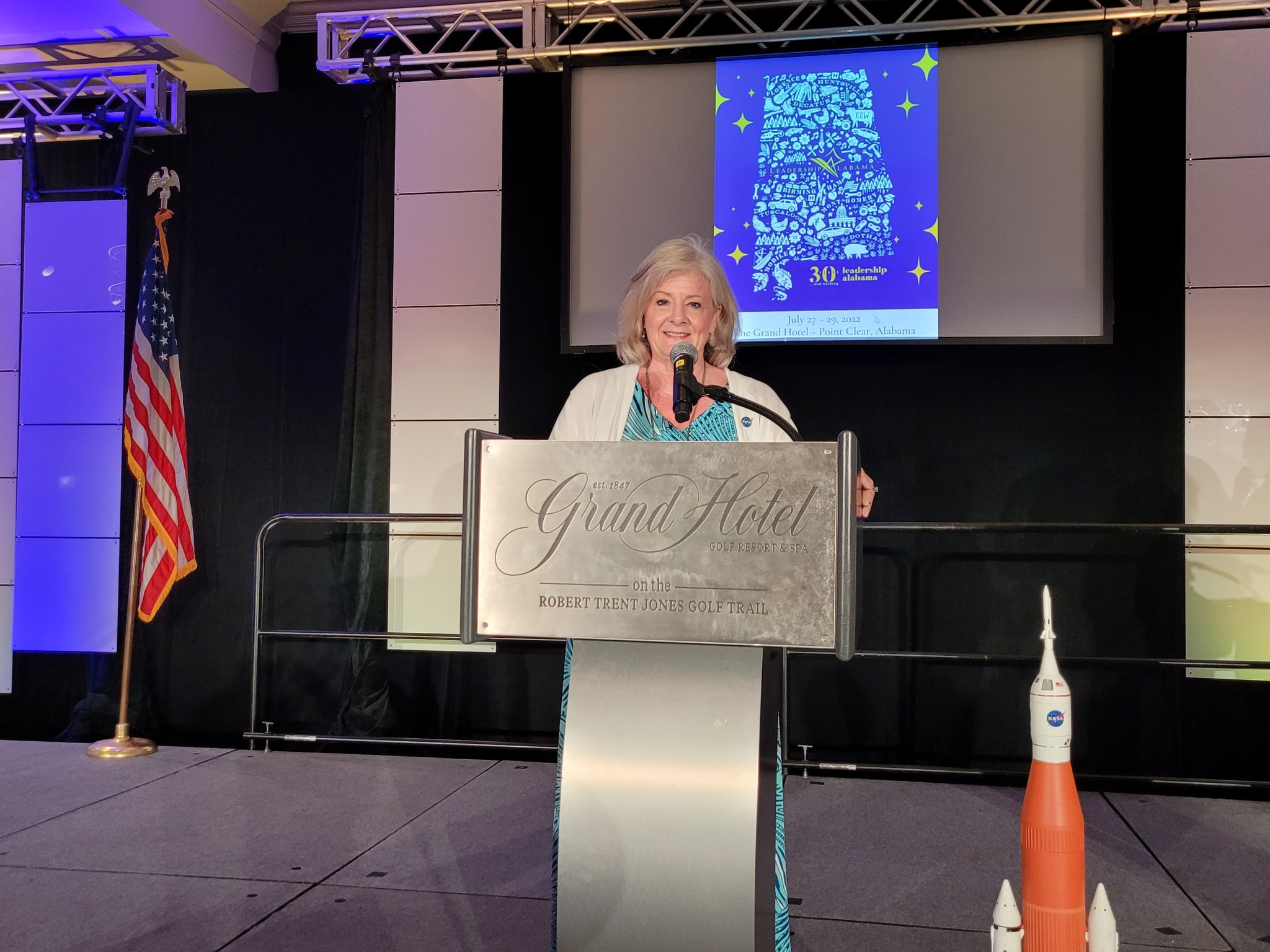
Jody Singer, director at NASA’s Marshall Space Flight Center, delivered a keynote address for the “30 Years… and Holding” Leadership Alabama Conference at the Grand Hotel in Point Clear, Alabama, on July 28. Singer spoke in front of 200 Alabama leaders and highlighted the rich history of not only Marshall, but Redstone Arsenal and the city of Huntsville. Singer also highlighted Marshall’s current capabilities, projects, and programs. “Building on our heritage of building rockets has led to the development of the latest and greatest rocket – the most powerful rocket ever built – the Space Launch System,” Singer said. “In a few short years when the next NASA astronauts land on the Moon as part of the Artemis III mission, they will do so in industry-led human landing systems, managed at Marshall. Our center leadership team has outlined pursuits to propel us into the future, focused on leveraging our people, processes, and infrastructure to adapt and meet future needs.” (Credits: NASA/Ashley Polesak)
Webb Captures Stellar Gymnastics in the Cartwheel Galaxy
NASA’s James Webb Space Telescope has peered into the chaos of the Cartwheel Galaxy, revealing new details about star formation and the galaxy’s central black hole. Webb’s powerful infrared gaze produced a detailed image of the Cartwheel and two smaller companion galaxies against a backdrop of many other galaxies. This image provides a new view of how the Cartwheel Galaxy has changed over billions of years.
The Cartwheel Galaxy, located about 500 million light-years away in the Sculptor constellation, is a rare sight. Its appearance, much like that of the wheel of a wagon, is the result of an intense event – a high-speed collision between a large spiral galaxy and a smaller galaxy not visible in the image. Collisions of galactic proportions cause a cascade of different, smaller events between the galaxies involved; the Cartwheel is no exception.
The collision most notably affected the galaxy’s shape and structure. The Cartwheel Galaxy sports two rings – a bright inner ring and a surrounding, colorful ring. These two rings expand outwards from the center of the collision, like ripples in a pond after a stone is tossed into it. Because of these distinctive features, astronomers call this a “ring galaxy,” a structure less common than spiral galaxies like our Milky Way.
The bright core contains a tremendous amount of hot dust with the brightest areas being the home to gigantic young star clusters. On the other hand, the outer ring, which has expanded for about 440 million years, is dominated by star formation and supernovas. As this ring expands, it plows into surrounding gas and triggers star formation.
Other telescopes, including the Hubble Space Telescope, have previously examined the Cartwheel. But the dramatic galaxy has been shrouded in mystery – perhaps literally, given the amount of dust that obscures the view. Webb, with its ability to detect infrared light, now uncovers new insights into the nature of the Cartwheel.
The Near-Infrared Camera (NIRCam), Webb’s primary imager, looks in the near-infrared range from 0.6 to 5 microns, seeing crucial wavelengths of light that can reveal even more stars than observed in visible light. This is because young stars, many of which are forming in the outer ring, are less obscured by the presence of dust when observed in infrared light. In the image, NIRCam data are colored blue, orange, and yellow. The galaxy displays many individual blue dots, which are individual stars or pockets of star formation. NIRCam also reveals the difference between the smooth distribution or shape of the older star populations and dense dust in the core compared to the clumpy shapes associated with the younger star populations outside of it.
Learning finer details about the dust that inhabits the galaxy, however, requires Webb’s Mid-Infrared Instrument (MIRI). It reveals regions within the Cartwheel Galaxy rich in hydrocarbons and other chemical compounds, as well as silicate dust, like much of the dust on Earth. These regions form a series of spiraling spokes that essentially form the galaxy’s skeleton. These spokes are evident in previous Hubble observations released in 2018, but they become much more prominent in this Webb image.
Webb’s observations underscore that the Cartwheel is in a very transitory stage. The galaxy, which was presumably a normal spiral galaxy like the Milky Way before its collision, will continue to transform. While Webb gives us a snapshot of the current state of the Cartwheel, it also provides insight into what happened to this galaxy in the past and how it will evolve in the future.
The James Webb Space Telescope is the world’s premier space science observatory. Webb will solve mysteries in our solar system, look beyond to distant worlds around other stars, and probe the mysterious structures and origins of our universe and our place in it. Webb is an international program led by NASA with its partners, ESA (European Space Agency) and the Canadian Space Agency. The Webb team at NASA’s Marshall Space Flight Center spent more than two decades working on Webb, primarily focusing on development and testing of the mirrors in extreme cold temperatures at which Webb operates.
Engineering Directorate Returns Project/Program Management Detail
Are you an engineer looking for an opportunity to expand your knowledge and skills? Would having a career in project/program management excite you? Are you a civil servant with a GS-12 or GS-13 paygrade in the Engineering Directorate? If you answered “yes” to these questions, please keep reading!
Marshall Space Flight Center’s Engineering Directorate recently returned its program – which launched in October 2021 – that offers midgrade-level engineers a three-month lateral detail assignment to gain insight into the various facets of project/program management. During the detail, participants will be mentored by an experienced project manager or subsystem manager.
The application period is open until 10:59 p.m. CDT on Monday, Aug. 22. Those interested should apply on NASA’s Talent Marketplace under Opportunity Number 30156.
“We see this program as an early-career development opportunity to strengthen the engineering-to-project-management pipeline,” said Roger Baird, Associate Director of Engineering Operations. “Several of our talented engineers at Marshall will experience the day-to-day workings of a project manager, with a chance to observe and participate in project/program management without making a career change.”
During the detail, participants will be placed in project management areas based on their skillsets, rotating through the Human Exploration Development & Operations, Landing System Program, Science & Technology, or Space Launch System Program offices.
The program aims for participants to learn how to interact with project managers and better understand how projects work, the management of risks, and why various decisions are made and how they are implemented at the project/program management level.
“Our goal is to help engineers discover if project management could be a future career for them,” Baird said. “Building relationships will be the heart of the program. After detail assignments are completed, we hope to achieve continued mentoring relationships between the project managers and engineers.”
For more information, contact Baird at 256-603-0031 or go here.






























